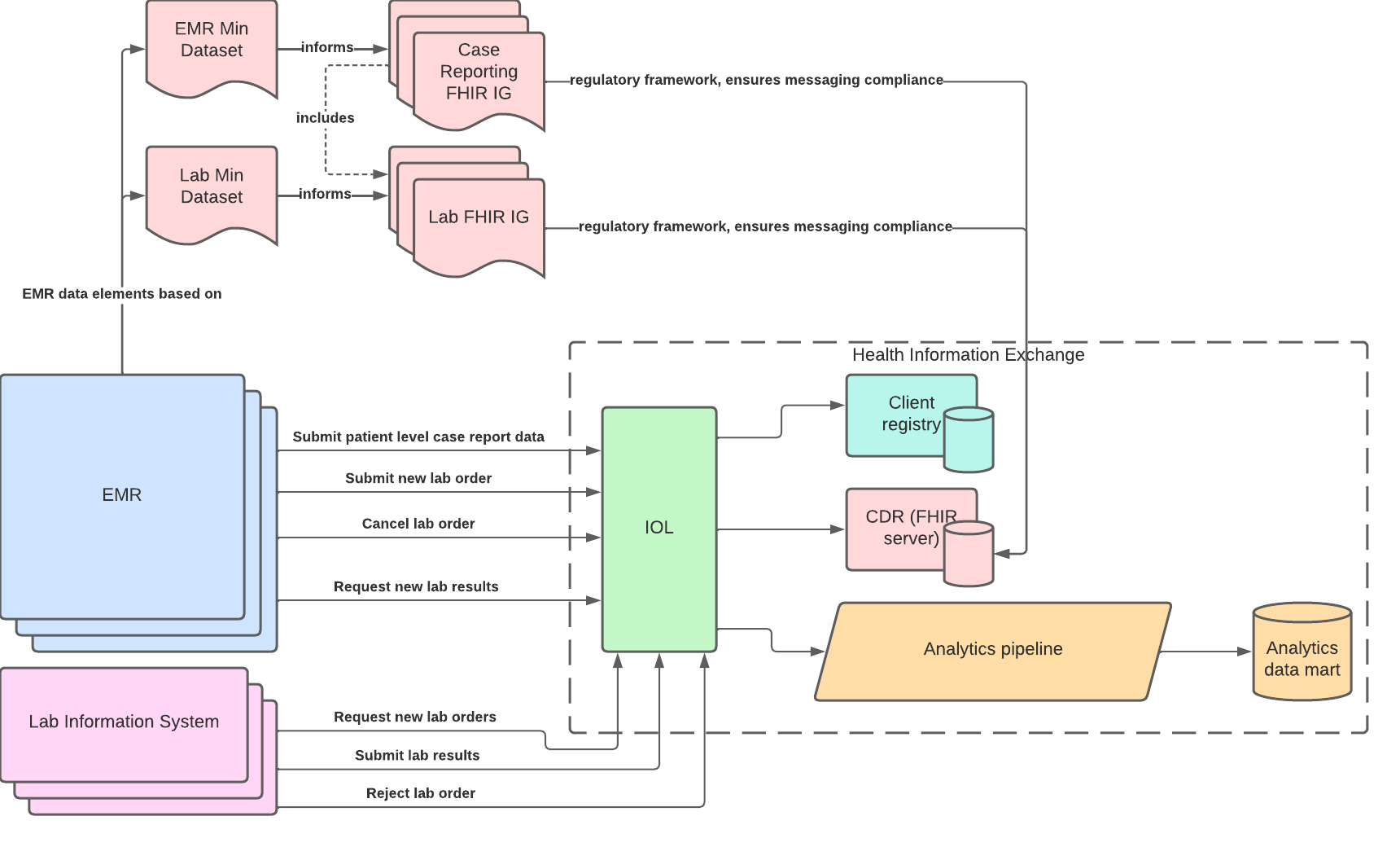HIV Program Monitoring and Patient Care Coordination
0.2.0 - CI Build
HIV Program Monitoring and Patient Care Coordination
0.2.0 - CI Build
HIV Program Monitoring and Patient Care Coordination, published by Jembi Health Systems. This is not an authorized publication; it is the continuous build for version 0.2.0). This version is based on the current content of https://github.com/openhie/HIV-Program-Monitoring-and-Patient-Care-Coordination and changes regularly. See the Directory of published versions
| Official URL: http://openhie.org/fhir/hiv-program-monitoring/ImplementationGuide/openhie.fhir.hiv.program-monitoring | Version: 0.2.0 | |||
| Draft as of 2023-04-04 | Computable Name: HIVProgramMonitoring | |||
Contents:
This Implementation Guide contains the specifications for HIV program monitoring and patient care coordination.
- This implementation guide and set of artifacts are still undergoing development.
- This content is only for demonstration purposes only.
- Providing Feedback: Please submit any issues via the Feedback link next to the appropriate section of the implementation guide
The ultimate goal of HIV treatment is to achieve viral suppression. Program management and patient care coordination refers to continuous use of data at patient level to systematically provide high quality services to patients and achieve maximum program impact.
As countries are working towards the attainment of the United Nations Programme on HIV/AIDS (UNAIDS) 95-95-95 goals, it is critical to understand gaps in the HIV continuum of care.
Key elements to program management and patient care coordination include; identification and linkage to treatment & care, retention and viral load monitoring (University of California, San Francisco et al., 2022).
Program management and patient care coordination serves both the needs of the patient and more broadly, achieving the goal of reaching epidemic control.
This means that all people living with HIV (PLHIV) should be identified, linked to treatment, and have continuity of treatment to achieve viral suppression.
Interruption/Complete disengagement from treatment increases the risk of continued HIV transmission and is a deterrent in the journey towards the attainment of the UNAIDS 95-95-95 goals (University of California, San Francisco et al., 2022).
This is a content specific implementation guide that has been derived from the HIV Program Monitoring and Patient Care Coordination Minimum Dataset in order to effectively report on the progress towards viral suppression.
Background
Establishing a Health Information Exchange (HIE) with the purpose of enabling HIV Program Monitoring & Patient Care Coordination is a very challenging task. Therefore, this implementation guide identifies a suitable reference platform architecture to assist those in need of establishing an architecture as such. This implementation guide will provide the messaging standards specification for the Data Integration Strategies & Implementation (DISI) reference platform architecture and implementations alike that are concerned with HIV Program Monitoring & Patient Care Coordination.
DISI proposes to create a standards-based reference platform architecture that would allow multiple countries to adopt a similar framework for generating reports that they require. Currently, there are two DISI Reference Implementations for data centralization and reporting, one for HIV and another for COVID19.
The DISI architecture brings forth a set of components that are common among HIV and COVID19.
The below generic architecture illustrates the high-level components for DISI and implementations alike to support case reporting and program monitoring in a HIE. For a more technical representation of the DISI architecture to support case reporting and program monitoring, please see the DISI Component Architecture.

Messaging & Testing
This specification defines the key FHIR messaging bundles needed to support HIV program monitoring & lab integration.
Using an application called Postman, you will be able to submit requests (message bundles) to the DISI Platform for processing & reporting.
There are two Postman Collections namely:
Please see our Postman Collections for HIV as well as the descriptions for each of the message bundles that exist in each postman collection.
Each of the these postman collections have been tailored to support end-to-end testing between the EMR and lab systems. Moreover, each collection comes with a set of postman variables which have been designed to randomly populate data for all key fields in all resources. This is a great way to carry out exploratory testing.
The use of postman variables also allows you to statically initiate variables to actual values you need.
Another way is to automate end-to-end testing over the data pipeline till the point that case report data is available in the analytics platform.
This Implementation Guide is targeted at the following typical audiences:
This is an R4 IG. None of the features it uses are changed in R4B, so it can be used as is with R4B systems. Packages for both R4 (openhie.fhir.hiv.program-monitoring.r4) and R4B (openhie.fhir.hiv.program-monitoring.r4b) are available.
| IG | Package | FHIR | Comment |
|---|---|---|---|
| openhie.fhir.hiv.program-monitoring#0.2.0 | R4 | ||
| hl7.terminology.r4#5.0.0 | R4 | Automatically added as a dependency - all IGs depend on HL7 Terminology |
There are no Global profiles defined
This publication includes IP covered under the following statements.
While this implementation guide and the underlying FHIR are licensed as public domain, this guide may include examples making use of terminologies such as LOINC, SNOMED CT and others which have more restrictive licensing requirements. Implementers should make themselves familiar with licensing and any other constraints of terminologies, questionnaires, and other components used as part of their implementation process. In some cases, licensing requirements may limit the systems that data captured using certain questionnaires may be shared with.
This specification is provided without warranty of completeness or consistency, and the official publication supersedes this draft. No liability can be inferred from the use or misuse of this specification, or its consequences.
This specification is based on FHIR and the FHIR tooling ecosystem and community processes. It has been defined with the support and participation of the following institutions.
Institutions
Contributors
Viewers